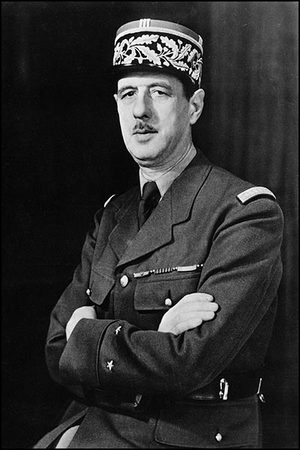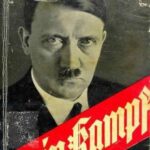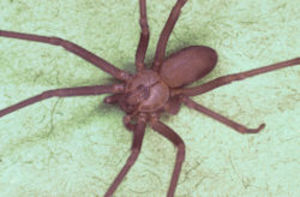Charles de Gaulle was a General who became President of France. He was a man who was very clever and could force himself into power and get others to do work for him and to support him. He was also a man with a very big nose and was sometimes called Cyrano after Cyrano de Bergerac. After Marshal Petain, who was the military leader, asked Hitler for peace during World War II, de Gaulle decided to become the leader of France. This seems very strange to me for someone to just “decide” to become leader of an important country.
De Gaulle was born on November 22, 1890 in Lille, France. He became a soldier before World War I and served with honor during that war. Between World War I and World War II he worked to modernize the French army. Not many people wanted to listen to him. . . except for the Germans, they liked his ideas, so it’s probably not surprising that the French army lost to the Germans in the first two weeks of fighting in May of 1940.
When de Gaulle went to England, he was able to persuade Winston Churchill to support him. He became the leader of the resistance movement, called the Free French, and worked to build up a new French army. Since no other leaders came to help, everybody accepted him as their leader. The interesting thing is that France’s colonies also accepted him as their leader. He became the co-president of the French Committee of National Liberation.
De Gaulle’s partner was General Henri Giraud. Learning how to become a good politician, he forced Giraud out of power in 1943 and became the solo president of the committee. In 1944, the United States government recognized the committee as the government of France, thus making de Gaulle the president of France. He resigned in November of 1945 because the people in the legislature would not give him more power.
After he left office, he started a new political party called the Rally of the People of France (RPF). This political movement only lasted until 1953 when he retired. In 1958, he was asked back to government as premier to help make a new constitution for France. Under the new constitution, he was elected president in 1959. He did a lot to return France to a role of importance in world affairs.
In 1965, he was elected to a second term as president under the new constitution. He made the United States and other former allies mad when he took France out of the North Atlantic Treaty Organization (NATO). In 1968, France’s economy was in trouble. Workers were striking and students were rioting. He got things stabilized by the next year, but he did not have the support he wanted from the people and the government so he retired in April of 1969. He died on November 7, 1970.
Sir Bernard Ledwidge, who was a minister to France and knew de Gaulle personally said, “De Gaulle had to exist so that France could continue to be France.” Some people say that de Gaulle was the greatest Frenchman since Napoleon. Ledwidge, a British subject, says that de Gaulle was the greatest Frenchman in the history of France. De Gaulle’s greatest strength, according to Ledwidge, was in giving France confidence, being willing to make the French people change, and always putting France first.
Sir Bernard also said that de Gaulle liked to portray himself like Julius Caesar and that he only remembers the important and good stuff that he did. But he also says he did this to help make France look good. My dad says that the French are still embarrassed that their “strongest army in Europe” was defeated in just two weeks. De Gaulle himself said “All my life I have thought of France in a certain way. . . The emotional side of me tends to imagine France like the princess of a fairy story or the Madonna. . . dedicated to an exalted and exceptional destiny. . . In short, to my mind, France cannot be France without greatness.” De Gaulle had to be great to make France be able to stay great.
References
Compton’s Pictured Encyclopedia. Vol. 6. Chicago: F. E. Compton and Co., 1956. p. 34.
de Gaulle, Charles. The Complete War Memoirs of Charles de Gaulle. New York: Da Capo Press, Inc., 1967. p. 3.
Funk and Wagnalls New Encyclopedia. Vol 8. Clifton, New Jersey: Funk and Wagnalls Corporation, 1993. pp. 94-95.
Ledwidge, Sir Bernard. De Gaulle. New York: St. Martin’s Press, 1982. pp. 384-385.




